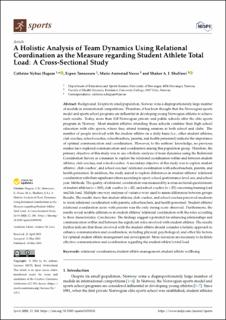| dc.identifier.citation | Hagum, C. N., Tønnessen, E., Nesse, M. A., & Shalfawi, S. A. I. (2023). A Holistic Analysis of Team Dynamics Using Relational Coordination as the Measure regarding Student Athlete Total Load: A Cross-Sectional Study. Sports, 11(5), 104. | en_US |
| dc.description.abstract | Background: Despite its small population, Norway wins a disproportionately large number of medals in international competitions. Therefore, it has been thought that the Norwegian sports model and sports school programs are influential in developing young Norwegian athletes to achieve such results. Today, more than 110 Norwegian private and public schools offer the elite sports program in Norway. Most student athletes attending those schools combine their high school education with elite sports, where they attend training sessions at both school and clubs. The number of people involved with the student athlete on a daily basis (i.e., other student athletes, club coaches, school coaches, schoolteachers, parents, and health personnel) indicate the importance of optimal communication and coordination. However, to the authors’ knowledge, no previous studies have explored communication and coordination among this population group. Therefore, the primary objective of this study was to use a holistic analysis of team dynamics using the Relational Coordination Survey as a measure to explore the relational coordination within and between student athletes, club coaches, and school coaches. A secondary objective of this study was to explore student athletes’, club coaches’, and school coaches’ relational coordination with schoolteachers, parents, and health personnel. In addition, the study aimed to explore differences in student athletes’ relational coordination with their significant others according to sport, school, performance level, sex, and school year. Methods: The quality of relational coordination was measured by a cross-sectional questionnaire of student athletes (n = 345), club coaches (n = 42), and school coaches (n = 25) concerning training load and life load. Multiple one-way analyses of variance were used to assess differences between groups. Results: The results show that student athletes, club coaches, and school coaches perceived moderate to weak relational coordination with parents, schoolteachers, and health personnel. Student athletes’ relational coordination score with parents was the only strong score observed. Furthermore, the results reveal notable differences in student athletes’ relational coordination with the roles according to their characteristics. Conclusions: The findings suggest a potential for enhancing relationships and communication within and between the significant roles involved with student athletes. The results further indicate that those involved with the student athlete should consider a holistic approach to enhance communication and coordination, including physical, psychological, and other life factors, for optimal student athlete management and development. More resources are necessary to facilitate effective communication and coordination regarding the student athlete’s total load. | en_US |

